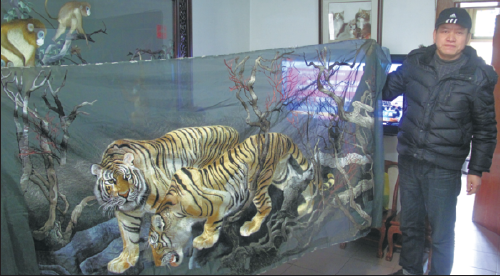
Peng Shiping shows off an embroidery piece that took him eight years to finish.[HUANG ZHILING/CHINA DAILY]
When he was 15, his father formally taught him embroidery techniques at home. Five years later, Peng started working in his father's factory. The next year, he spent eight months stitching his first work of double-sided embroidery. On one side were birds and camellia flowers. On the other butterflies flew around oleanders.
"Current embroidery methods carry forward solid old traditions, but it also makes some innovations in stitching and modeling," says Zhao Xiaomei, a silk expert in the Chengdu Shu Brocade and Embroidery Museum.
"Traditional embroidery needlework displays patterns only on one side, but today artists produce two-sided embroidery pieces, stitching different patterns on either side of the same satin cloth.
"In some amazing designs, one side displays a cat, and the other a fish. Both figures are done on a single piece of transparent fabric and both are completed at the same time."
Peng has won many prizes for his double-sided embroidery pieces in international fairs. It takes him about one year to complete a single work.
In 1989, his double-sided embroidery featuring Sima Xiangru and Zhuo Wenjun on one side and two pandas on the other, won a gold prize in the First Beijing International Fair.
Before he began that work, he was not sure how the pandas' front paws should look. He spent days studying books and pictures of pandas to get a clear idea of the structure of their paws, nails and hair.
"Some days, all I thought about was how pandas moved with their front paws," he says.
To improve his needlework skills, Peng took painting courses at night after he joined the Chengdu Shu Embroidery School. He also buys paintings that inspire him. On the wall in the living room of his apartment, for example, is a gigantic painting of a panda by Li Yan, a master painter from Hunan province.
Pandas are a recurring subject in Shu embroidery. To observe them, Peng visits the Chengdu Zoo twice a year.
His wife, Zhang Youhua, says Peng works on embroidery for more than 10 hours every day. One needle he has used for three years has been worn to one-third of its original length. Peng always keeps his five needles in the pocket to keep them warm so that they will not rust.
To prevent his hands from getting rough, Peng does no housework at home, his wife says affectionately. Visitors are impressed with his hands which look like those of a 20-year-old.
In the time of Peng's father, only men stitched the embroidery. "Now the number of male embroiderers is fewer than five in Chengdu. Almost all the embroiderers are women," Peng says.
Fewer people are willing to learn embroidery because of the repetitive work and meager income. Embroiderers tend to suffer from neck and back pain. They are required to shun spicy food and liquor, which are believed to hurt the kidneys. According to traditional Chinese medicine, a poor kidney diminishes one's eyesight.
More than 20 young women have learned embroidery from Peng in his studio in the past two years, but he worries about the future of the art, which is more than 2,000 years old. "Many older master embroiderers are preoccupied with doing business and selling works of embroidery. They have no time to stitch and only sign their names on embroidery works by their students," Peng says.
To his delight, his only daughter Peng Lin likes stitching in her spare time and has mastered all the techniques. The 26-year-old has graduated from Xihua University in Chengdu as an English major.
"I plan to work exclusively on embroidery," she says.
We recommend:
